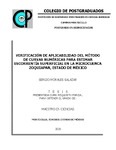| dc.contributor.author | Morales Salazar, Sergio | |
| dc.creator | MORALES SALAZAR, SERGIO; 856119 | |
| dc.date.accessioned | 2020-02-07T15:01:26Z | |
| dc.date.available | 2020-02-07T15:01:26Z | |
| dc.date.issued | 2020-01 | |
| dc.identifier.uri | http://hdl.handle.net/10521/4242 | |
| dc.description | Tesis (Maestría en Ciencias, especialista en Hidrociencias).- Colegio de Postgraduados, 2020. | es_MX |
| dc.description.abstract | La presente investigación tiene como finalidad la evaluación de escurrimientos superficiales en nivel de ladera y en la desembocadura de la microcuenca Zoquiapan, Estado de México. Se centra en analizar el método de curvas numéricas (CN) desarrollado por el Servicio de Conservación de Suelos para predecir el volumen de escurrimiento por evento de lluvia. En ladera se determinaron cinco tipos de Unidades Hidrológicas (UH) en función del tipo de suelo, especie y densidad forestal; en cada UH se instalaron dos lotes de escurrimiento de 6.25 m² para medir el volumen de escurrimiento y tener las bases para generar números de curva en cada UH. Después de calibrar las CN tabuladas, con base en el método de curva asintótica, el escurrimiento fue de 34 831.0 m³ con un R2 de 0.63, un coeficiente de Nash-Sutcliffe de 0.4 (bueno) y una sobrestimación promedio por evento del 1.7% (pendiente de la línea de regresión interceptando el origen) respecto al escurrimiento superficial medidos en lotes que fue de 33 249.7 m³. En esta etapa de la investigación se concluyó que el método CN es de utilidad para estimar escurrimientos superficiales siempre y cuando se considere el respectivo ajuste a los números de curva. En la desembocadura de la microcuenca se analizaron y compararon los escurrimientos superficiales transcurridos en un canal tipo Parshall modificado con el método CN obteniendo un R² de 0.71 entre lo medido y calculado por el método. Finalmente, con los datos obtenidos se realizó el balance hidrológico para la microcuenca, definiendo que el 18 % de la precipitación genera escurrimientos superficiales durante el periodo de análisis. _______________ VERIFICATION OF APPLICABILITY OF CURVE NUMBER METHOD FOR SURFACE RUNOFF IN THE WATERSHED ZOQUIAPAN, STATE OF MEXICO. ABSTRACT: The purpose of this research is to evaluate surface runoff at the hillside level and at the mouth of the Zoquiapan microbasin, State of Mexico. It focuses on analyzing the method of numerical curves (CN) developed by the Soil Conservation Service to predict the volume of runoff per rain event. On the hillside, five types of Hydrological Units (UH) were determined based on the type of soil, species and forest density; in each UH two 6.25 m² runoff lots were installed to measure the runoff volume and have the basis for generating curve numbers in each UH. After calibrating the tabulated CNs, based on the asymptotic curve method, the runoff was 34 831.0 m³ with an R2 of 0.63, a Nash-Sutcliffe coefficient of 0.4 (good) and an average overestimation per event of 1.7% (slope of the regression line intercepting the origin) with respect to the surface runoff measured in lots that was 33 249.7 m³. At this stage of the investigation it was concluded that the CN method is useful for estimating surface runoff as long as the respective adjustment to the curve numbers is considered. At the mouth of the microbasin, the surface runoffs in a modified Parshall type channel were analyzed and compared with the CN method, obtaining a R² of 0.71 between the measured and calculated by the method. Finally, with the data obtained, the hydrological balance for the microbasin was carried out, defining that 18% of the precipitation generates surface runoff during the analysis period. | es_MX |
| dc.format | pdf | es_MX |
| dc.language.iso | spa | es_MX |
| dc.rights.uri | http://creativecommons.org/licenses/by-nc-nd/4.0 | es_MX |
| dc.subject | Lotes de escurrimiento | es_MX |
| dc.subject | Curva asintótica | es_MX |
| dc.subject | Bosque templado | es_MX |
| dc.subject | Método empírico | es_MX |
| dc.subject | Canal Parsall modificado | es_MX |
| dc.subject | Runoff lots | es_MX |
| dc.subject | Asymptotic curve | es_MX |
| dc.subject | Temperate forest | es_MX |
| dc.subject | Empirical method | es_MX |
| dc.subject | Modified Parsall canal | es_MX |
| dc.subject | Hidrociencias | es_MX |
| dc.subject | Maestría | es_MX |
| dc.subject.classification | CIENCIAS FÍSICO MATEMÁTICAS Y CIENCIAS DE LA TIERRA::CIENCIAS DE LA TIERRA Y DEL ESPACIO::HIDROLOGÍA | es_MX |
| dc.title | Verificación de aplicabilidad del método de curvas numéricas para estimar escorrentía superficial en la microcuenca Zoquiapan, Estado de México. | es_MX |
| dc.type | Tesis | es_MX |
| Tesis.contributor.advisor | Macedo Cruz, Antonia | |
| Tesis.contributor.advisor | Villegas Romero, Isidro | |
| Tesis.contributor.advisor | Fernández Reynoso, Demetrio Salvador | |
| Tesis.date.submitted | 2020-01 | |
| Tesis.date.accesioned | 2020 | |
| Tesis.date.available | 2020 | |
| Tesis.format.mimetype | pdf | es_MX |
| Tesis.format.extent | 6,131 KB | es_MX |
| Tesis.subject.nal | Subcuencas | es_MX |
| Tesis.subject.nal | Subwatersheds | es_MX |
| Tesis.subject.nal | Conservación de suelos | es_MX |
| Tesis.subject.nal | Soil conservation | es_MX |
| Tesis.subject.nal | Parques Nacionales | es_MX |
| Tesis.subject.nal | National Parks | es_MX |
| Tesis.subject.nal | Cuencas hidrográficas | es_MX |
| Tesis.subject.nal | Watersheds | es_MX |
| Tesis.subject.nal | Estado de México, México | es_MX |
| Tesis.rights | Acceso abierto | es_MX |
| Articulos.subject.classification | Cuencas hidrográficas | es_MX |
| dc.type.conacyt | masterThesis | es_MX |
| dc.identificator | 1||25||2508 | es_MX |
| dc.contributor.director | MACEDO CRUZ, ANTONIA; 94273 | |
| dc.audience | generalPublic | es_MX |


